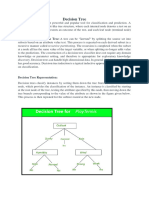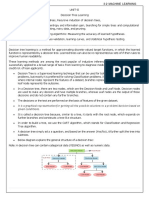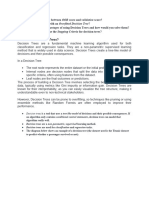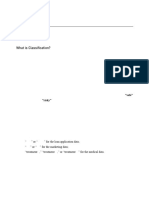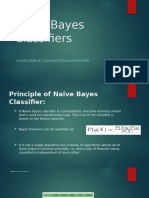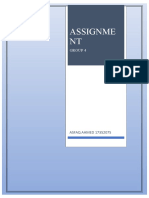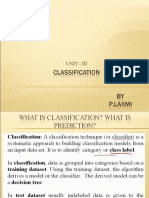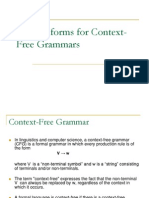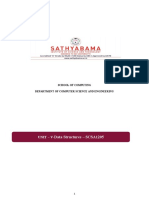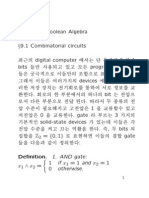Decision Tree
Decision Tree
Uploaded by
Shrutika ranjanCopyright:
Available Formats
Decision Tree
Decision Tree
Uploaded by
Shrutika ranjanOriginal Description:
Copyright
Available Formats
Share this document
Did you find this document useful?
Is this content inappropriate?
Copyright:
Available Formats
Decision Tree
Decision Tree
Uploaded by
Shrutika ranjanCopyright:
Available Formats
Courses Write an Article
Decision Tree
Decision Tree : Decision tree is the most powerful and popular tool for classification
and prediction. A Decision tree is a flowchart like tree structure, where each internal
node denotes a test on an attribute, each branch represents an outcome of the test, and
each leaf node (terminal node) holds a class label.
A decision tree for the concept PlayTennis.
Construction of Decision Tree :
A tree can be “learned” by splitting the source set into subsets based on an attribute
value test. This process is repeated on each derived subset in a recursive manner
calledrecursive partitioning. The recursion is completed when the subset at a node all
has the same value of the target variable, or when splitting no longer adds value to the
predictions. The construction of decision tree classifier does not require any domain
knowledge or parameter setting, and therefore is appropriate for exploratory knowledge
discovery. Decision trees can handle high dimensional data. In general decision tree
classifier has good accuracy. Decision tree induction is a typical inductive approach to
learn knowledge on classification.
Decision Tree Representation :
Decision trees classify instances by sorting them down the tree from the root to some
leaf node, which provides the classification of the instance. An instance is classified by
starting at the root node of the tree,testing the attribute specified by this node,then
moving down the tree branch corresponding to the value of the attribute as shown in the
above figure.This process is then repeated for the subtree rooted at the new node.
The decision tree in above figure classifies a particular morning according to whether it
is suitable for playing tennis and returning the classification associated with the
particular leaf.(in this case Yes or No).
For example,the instance
(Outlook = Rain, Temperature = Hot, Humidity = High, Wind = Strong )
would be sorted down the leftmost branch of this decision tree and would therefore be
classified as a negative instance.
In other words we can say that decision tree represent a disjunction of conjunctions of
constraints on the attribute values of instances.
(Outlook = Sunny ^ Humidity = Normal) v (Outllok = Overcast) v (Outlook = Rain ^ Wind
= Weak)
Strengths and Weakness of Decision Tree approach
The strengths of decision tree methods are:
Decision trees are able to generate understandable rules.
Decision trees perform classification without requiring much computation.
Decision trees are able to handle both continuous and categorical variables.
Decision trees provide a clear indication of which fields are most important for
prediction or classification.
The weaknesses of decision tree methods :
Decision trees are less appropriate for estimation tasks where the goal is to
predict the value of a continuous attribute.
Decision trees are prone to errors in classification problems with many class and
relatively small number of training examples.
Decision tree can be computationally expensive to train. The process of growing
a decision tree is computationally expensive. At each node, each candidate
splitting field must be sorted before its best split can be found. In some
algorithms, combinations of fields are used and a search must be made for
optimal combining weights. Pruning algorithms can also be expensive since
many candidate sub-trees must be formed and compared.
You might also like
- Decision TreeDocument2 pagesDecision Treejayantimisra36No ratings yet
- Data Minin1Document104 pagesData Minin1Aryasree M.DNo ratings yet
- Unit-3 Decision Tree Learning (Februray 26, 2024)Document51 pagesUnit-3 Decision Tree Learning (Februray 26, 2024)nikhilbadlani77No ratings yet
- Decision TreeDocument21 pagesDecision Treeaditya.cse121118No ratings yet
- Decision TreeDocument31 pagesDecision TreepatricknamdevNo ratings yet
- Decision TreeDocument57 pagesDecision TreeArjun KhoslaNo ratings yet
- Konsep EnsembleDocument52 pagesKonsep Ensemblehary170893No ratings yet
- Unit 3 Classification - Dr. Vidyut DDocument72 pagesUnit 3 Classification - Dr. Vidyut DDASH CAM SHORTSNo ratings yet
- Decision TreeDocument57 pagesDecision TreePrabhjit Singh100% (1)
- Machine LearningDocument8 pagesMachine LearningRowa salmanNo ratings yet
- Decision Tree LearningDocument11 pagesDecision Tree Learningbenjamin212No ratings yet
- Decisiontree 2Document16 pagesDecisiontree 2shilpaNo ratings yet
- 5 Review PaperDocument7 pages5 Review PaperGorishsharmaNo ratings yet
- Lecture Notes 3Document11 pagesLecture Notes 3vivek guptaNo ratings yet
- Decision Tree ComprehesiveDocument7 pagesDecision Tree ComprehesiveKiruthiga SivaramanNo ratings yet
- 10 2Document10 pages10 2uxamaNo ratings yet
- Decision Tree Algorithm: and Classification Problems TooDocument12 pagesDecision Tree Algorithm: and Classification Problems TooAva WhiteNo ratings yet
- DecisionTree Numerical ID3ProbDocument114 pagesDecisionTree Numerical ID3ProbHARSH NAYANNo ratings yet
- Unit Iir20Document22 pagesUnit Iir20Yadavilli VinayNo ratings yet
- Decision Trees Set-1Document7 pagesDecision Trees Set-1Kiruthiga SivaramanNo ratings yet
- Decision Tree Algorithm, Explained-1-22Document22 pagesDecision Tree Algorithm, Explained-1-22shylaNo ratings yet
- Ecision Tree: Balaram ChampannavarDocument7 pagesEcision Tree: Balaram ChampannavarBalaram ChampannavarNo ratings yet
- Decision TreesDocument14 pagesDecision TreesJustin Russo Harry50% (2)
- Decision TreeDocument5 pagesDecision Treeprakash.omprakash.om1No ratings yet
- Module - 3 - DTL & AnnDocument10 pagesModule - 3 - DTL & AnnsuryakiranaNo ratings yet
- 4 ClassificationDocument20 pages4 ClassificationthirosulNo ratings yet
- Unit 1Document12 pagesUnit 1Lakshmi Nandini MenteNo ratings yet
- Decision Trees and How To Build and Optimize Decision Tree ClassifierDocument16 pagesDecision Trees and How To Build and Optimize Decision Tree ClassifierShalini SinghalNo ratings yet
- Machine Learning: MVJ21CS62Document12 pagesMachine Learning: MVJ21CS62rohithlokesh2912No ratings yet
- Data MiningDocument68 pagesData MiningIpsitaNo ratings yet
- Data Mining Algorithms Classification L4Document7 pagesData Mining Algorithms Classification L4u- m-No ratings yet
- UCS551 Chapter 6 - ClassificationDocument20 pagesUCS551 Chapter 6 - Classificationnur ashfaralianaNo ratings yet
- Data Mining Unit-IiiDocument36 pagesData Mining Unit-Iii22831a05f1No ratings yet
- Decision Tree Algorithm, ExplainedDocument20 pagesDecision Tree Algorithm, ExplainedAli KhanNo ratings yet
- Slide 3Document23 pagesSlide 3Muhammad Ibrahim IsahNo ratings yet
- AI Unit 4Document15 pagesAI Unit 4b210698No ratings yet
- Decision Tree RDocument5 pagesDecision Tree RDivya BNo ratings yet
- Unit IiDocument22 pagesUnit IiManohar 6666No ratings yet
- Data Analytics - Unit-IVDocument21 pagesData Analytics - Unit-IVbhavya.shivani1473No ratings yet
- DM Module 4Document12 pagesDM Module 4abhiramsurya48No ratings yet
- AIML Module-04Document46 pagesAIML Module-04AISHWARYA HOYSALNo ratings yet
- DataminingDocument3 pagesDataminingAbhishek GhoshNo ratings yet
- DecisiontreeDocument6 pagesDecisiontreeishita.sengupta.06No ratings yet
- ML Unit 3Document14 pagesML Unit 3aiswaryaNo ratings yet
- Decision TreeDocument16 pagesDecision Treedebasmita.sahaNo ratings yet
- MLunit 2 MynotesDocument15 pagesMLunit 2 MynotesVali BhashaNo ratings yet
- Improving Geometrical Structure of Data Using Geometric Decision TreeDocument6 pagesImproving Geometrical Structure of Data Using Geometric Decision TreeInternational Journal of Application or Innovation in Engineering & ManagementNo ratings yet
- 08 Decision - TreeDocument9 pages08 Decision - TreeGabriel GheorgheNo ratings yet
- ML Unit 3 Part 3Document33 pagesML Unit 3 Part 3jkdprince3No ratings yet
- DWDM Asgmnt ProgDocument51 pagesDWDM Asgmnt Progcopy leaksNo ratings yet
- Unit - IiiDocument52 pagesUnit - IiiLaxmiNo ratings yet
- Decision TreeDocument16 pagesDecision TreeaecsaranyaduraiNo ratings yet
- 1.decision Trees ConceptsDocument70 pages1.decision Trees ConceptsSuyash JainNo ratings yet
- Decision Tree LearningDocument15 pagesDecision Tree LearningdbaechtelNo ratings yet
- 1.0 Modeling: 1.1 ClassificationDocument5 pages1.0 Modeling: 1.1 ClassificationBanujan KuhaneswaranNo ratings yet
- Faculty of Information Management Universiti Teknologi Mara Puncak PerdanaDocument8 pagesFaculty of Information Management Universiti Teknologi Mara Puncak PerdanaNabila IbrahimNo ratings yet
- Decision Tree (Autosaved)Document14 pagesDecision Tree (Autosaved)Bhardwaj DiwakarNo ratings yet
- Alshibaia - 2Document18 pagesAlshibaia - 2phrishaNo ratings yet
- Gen. Math Summary of Topics2Document7 pagesGen. Math Summary of Topics2Rann M100% (1)
- Normal Forms For Context Free GrammarsDocument43 pagesNormal Forms For Context Free GrammarsjudesahayarajNo ratings yet
- Unit 1 - Discrete Structures - WWW - Rgpvnotes.inDocument29 pagesUnit 1 - Discrete Structures - WWW - Rgpvnotes.inSumit KumarNo ratings yet
- Buehler - Classical Metalogic PDFDocument158 pagesBuehler - Classical Metalogic PDFJair GallegosNo ratings yet
- Faculty of Information Technology and Multimedia CommunicationDocument5 pagesFaculty of Information Technology and Multimedia CommunicationIshmael Jayden Mdluli NyathiNo ratings yet
- Dynamic ProgrammingDocument27 pagesDynamic ProgrammingD07Vaishnavi ShindeCENo ratings yet
- WEEK 3 Language of Mathematics SETSDocument14 pagesWEEK 3 Language of Mathematics SETSBelle CaldeaNo ratings yet
- Where, In, Logical, Like OperatorDocument12 pagesWhere, In, Logical, Like OperatorSatyam TiwariNo ratings yet
- Implementationof Fuzzy Tsukamoto Algorithmin Determining Work FeasibilityDocument5 pagesImplementationof Fuzzy Tsukamoto Algorithmin Determining Work Feasibilitydikson piterNo ratings yet
- NPC - Print ItDocument22 pagesNPC - Print ItbayentapasNo ratings yet
- Algorithm:: Experiment No: 03 Experiment Name: Write A Program Implementation of AimDocument3 pagesAlgorithm:: Experiment No: 03 Experiment Name: Write A Program Implementation of AimRasel MadberNo ratings yet
- Genmath q2 Mod16 Truthvaluesofpropositions v2Document24 pagesGenmath q2 Mod16 Truthvaluesofpropositions v2Ofelia Aljade RamosNo ratings yet
- Taller Chapter 3 Sistemas DigitalesDocument4 pagesTaller Chapter 3 Sistemas DigitalesCristian PuentesNo ratings yet
- Practical-9: Implementation of Knapsack Problem Using Greedy AlgorithmDocument4 pagesPractical-9: Implementation of Knapsack Problem Using Greedy AlgorithmHarshNo ratings yet
- GE 5 Mathematics in The Modern WorldDocument31 pagesGE 5 Mathematics in The Modern Worldstephaniejeancortez522No ratings yet
- Mathematical Language and SymbolsDocument4 pagesMathematical Language and SymbolsRachel Anne BodlisNo ratings yet
- Unit I (Design and Analysis of Algorithm)Document181 pagesUnit I (Design and Analysis of Algorithm)thatanimeweeb09No ratings yet
- Notes DataDocument31 pagesNotes DataG KalaiarasiNo ratings yet
- Lec 02 - Recursive DefinitionDocument33 pagesLec 02 - Recursive DefinitionRooni KhanNo ratings yet
- What Is Data Types in C Language ?: Datatype Specific The Size & Type of Values That Can Be Stored in An VariableDocument9 pagesWhat Is Data Types in C Language ?: Datatype Specific The Size & Type of Values That Can Be Stored in An VariableGovindramNo ratings yet
- Metode Iterasi Titik TetapDocument17 pagesMetode Iterasi Titik TetapNur Aprilia DzulhijjahNo ratings yet
- Module 4 - LogicDocument12 pagesModule 4 - LogicRafael EusebioNo ratings yet
- X X Ifx OtherwiseDocument29 pagesX X Ifx OtherwiseCarloNo ratings yet
- AI - Experiment 6 - Alpha Beta PruningDocument6 pagesAI - Experiment 6 - Alpha Beta PruningAryaman GandhiNo ratings yet
- Decisions: Decision Making in JavaDocument50 pagesDecisions: Decision Making in Javambaziira eddyNo ratings yet
- 11 Math Eng 2018Document231 pages11 Math Eng 2018Karuna SuriNo ratings yet
- Fuzzy Groups ThesisDocument7 pagesFuzzy Groups Thesisheatherbeninatianchorage100% (2)
- Operations Research An Introduction NintDocument10 pagesOperations Research An Introduction Nintdoalbe4100% (1)
- Week 4 Notes - (Logics)Document7 pagesWeek 4 Notes - (Logics)motherfucker2222No ratings yet
